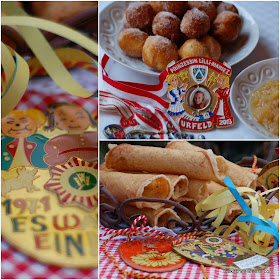Thursday marks the official beginning of “Carnival”. It goes by many names in German, depending on the region and dialect. Whether you call it “Fastnacht”, “Fasching” or “Karneval”, it is a time for revelry, humor, and satire. The actual celebrations of the German Carnival take place 40 days before Easter, it is like a last week-long party before Ash Wednesday (“Aschermittwoch”) and the beginning of Lent (“Fastenzeit”).
|
Donnerstag markiert den offiziellen Beginn des Karnivals. Er hat viele Namen in Deutsch, je nach Region und Dialekt. Ob man es "Fastnacht", "Fasching" oder "Karneval" nennt, es ist in jedem Fall eine Zeit zum Feiern, des Humors und der Satire. Die eigentlichen Feierlichkeiten des deutschen Karnevals beginnen 40 Tage vor Ostern, es ist wie eine letzte lange Party vor Aschermittwoch und somit dem Beginn der Fastenzeit. |
On Thursday, the Carnival celebrations kick off with Women’s Carnival Day (“Weiberfastnacht”) at exactly 11.11 a.m. The next highlight is Rose Monday (“Rosenmontag”). Marching bands, dancers, and floats parade down city streets. The participants of the parades throw confetti, sweets, little bundles of flowers and toys to the eager costumed crowds lining the streets where the parades take place. The elaborate floats often show caricatured figures mocking politicians and other personalities and thousands of dressed-up Germans are flocking the streets every year to watch these spectacles.
|
An Weiberfastnacht um 11:11 Uhr geht es dann endlich los. Und am Rosenmontag gibt es traditionelle Karnevalszüge in vielen deutschen Städten. Die Züge bestehen aus Abordnungen der Karnevalsvereine mit Prunkwagen, Kapellen, Tanzgruppierungen und oft auch aus so genannten Motivwagen. Letztere stellen oft Ereignisse und Personen des vergangenen Jahres in satirisch interpretierter Form dar. Von den Prunkwagen und den teilnehmenden Gruppen des Umzugs werden Kamelle und Blumen unter die Zuschauer geworfen. |
Almost every German city celebrates Carnival and organizes a street parade in its city center. The best and most traditional Carnival festivities take place in the Cities of Düsseldorf, Münster, Aachen, Mainz, and, of course my beloved hometown, Cologne.
On Shrove Tuesday ("Veilchendienstag"), costume balls are held all over Germany, while the quiet Ash Wednesday ("Aschermittwoch") marks the end of the frenzied fun. |
Fast jede deutsche Stadt feiert Karneval und organisiert einen Karnevalsumzug in der Innenstadt. Im Rheinland finden die besten und traditionsreichsten Karnevals-Feierlichkeiten in den Städten Düsseldorf, Münster, Aachen, Mainz und natürlich in meiner geliebten Heimatstadt Köln, statt. Am Veilchendienstag finden viele Kostümbälle statt und am Aschermittwoch beginnt die 40-tägige Fastenzeit und somit steht dieser Tag für das Ende der Karnevalssaison. |
As with every longstanding traditional holiday, special sweet treats are also served during the Carnival season. So during the next couple of days, the so-called "fifth season" ("fünfte Jahreszeit"), I will be baking some very tasty Carnival treats.
Pastries that are particular to Carnival and are prepared as a special pre-Lenten delicacy include the wonderful Fried Almond Cookies (“Mutzemandeln”), pictured below, the recipe for these will follow in my next post... |
Passend zur Saison gibt es natürlich jede Menge süße Karnevalsrezepte. Während der nächsten paar Tage, der so genannten "fünften Jahreszeit", werde ich einige wunderbare traditionellen Karnevals-Leckereien backen. Zum traditionellen Karnevalsgebäck gehören zum Beispiel die allseits beliebten Mutzemandeln, das Rezept kommt im nächsten Post, habe es heute nochmal ausprobiert… |
…or crunchy Waffle Rolls (“Eiserkuchen”) that are baked in a specialty waffle maker. The recipe that I am using is like the one my grandma Clara used to make. Unfortunately, the original recipe card is nowhere to be found....
|
….oder Eiserkuchen, die in einem speziellen Waffeleisen gebacken werden. Mein Rezept ist angelehnt an das Rezept meiner Oma Clara - leider ist das Orginal verloren gegangen.. |
Today, I am featuring a recipe for traditional Quark Doughnut Strips.
|
Heute beginne ich meine Karnevals-Bäckerei mit traditionellen Quarknudeln. |
Quark Doughnut Strips
(makes about 20)
Ingredients for the Doughnut Strips
|
Quarknudeln (ergibt ungefähr 20 Stück) Zutaten für die Quarknudeln
|
In addition
Preparation of the Doughnut Strips
|
Zusätzlich
Zubereitung der Quarknudeln
|
Let the Carnival celebrations begin!
|
Lasst die Karnevalssaison beginnen! |
































